The Rebel T4i is the first Canon DSLR to feature full-time AF in video mode. The past Canon DSLRs have featured the ability to force an AF confirmation using a slow and clunky contrast-detect method, which was simply unusable during video capture. Another AF confirmation option has been to use the cameras’ phase detection sensors; however, this caused a blackout during live view thanks to the mirror flipping down in front of the image sensor.
The folks over at Chipworks [via Image Sensors World] tore down a Rebel T4i to get a look at the image sensor and reveal phase detection sensors mixed among the pixels. This is something that Canon has been cooking on for a while. (Note this patent application that I discussed back in 2010.)
![]()
And while we’ve seen this concept implemented in prior cameras (notably the Fuji F300EXR point and shoot camera and Nikon 1 Series), Canon has gone about it in a technically different way to make it effective for DSLRs.

…we can see that unlike the Aptina sensor Canon is using a somewhat irregular pixel pattern for phase detection versus Aptina that used a set of regular lines. –Chipworks
![]()
Given the presence of this sensor in the Rebel T4i, you can bet that a similar sensor design with built-in phase detection pixels will find its way into the upcoming Canon mirrorless camera. This should really boost the reliability and speed of the mirrorless models’ AF. (I don’t really give much credence to Nikon’s very consumer-ish entry into the mirrorless market with its 1 Series models and the small 2.7x crop sensors.)
Hopefully, Canon’s design will lead to the ability to select much smaller AF points in live view systems. For me, those large AF “points” on mirrorless cameras have been the primary cause for me to pick up my DSLR over a more compact mirrorless camera on many outings. If I could be sure the AF area was small enough to nail focus on the eyes, I would go with a mirrorless camera more often.
If Canon can get a sensor like this tuned right for its mirrorless camera and give it a more “pro AF” feature set, then Canon just might have a chance at shaking up the established mirrorless market.
Your thoughts?



Can’t speak for all mirrorless cameras, but on the E-M5 you can adjust the size of the focus boxes. Not sure, but I believe other m4/3 cameras can do this as well. I’ve been using the E-M5 for a couple of weeks, and autofocus has been very, very accurate. Far more accurate than my Nikon D7000. No fine-tuning individual lenses either, like with all the DSLRs I’ve used. With a single button press I can get a smaller AF box when I need it for increased precision, and I can also manually tweak focus with a magnified view simply by “riding” the focus ring. Very quick, very easy. As someone who shoots mostly static subjects, I’m not too concerned about the E-M5’s tracking abilities… though I imagine in time, all mirrorless cameras will include phase detection sensors on the the image sensor. That is, unless/until someone comes up with a better solution. I was a strong skeptic when it came to mirrorless. Didn’t think I’d ever make the switch. Right now, I’m not missing my DSLR at all.
Mirrorless is the future of all pro cameras. You’ll see this before two years are out. DSLR, RIP.
DSLR dead, Not likely, By definition a mirrorless camera doesn’t have a viewfinder thus impractical for 95% of professionals.